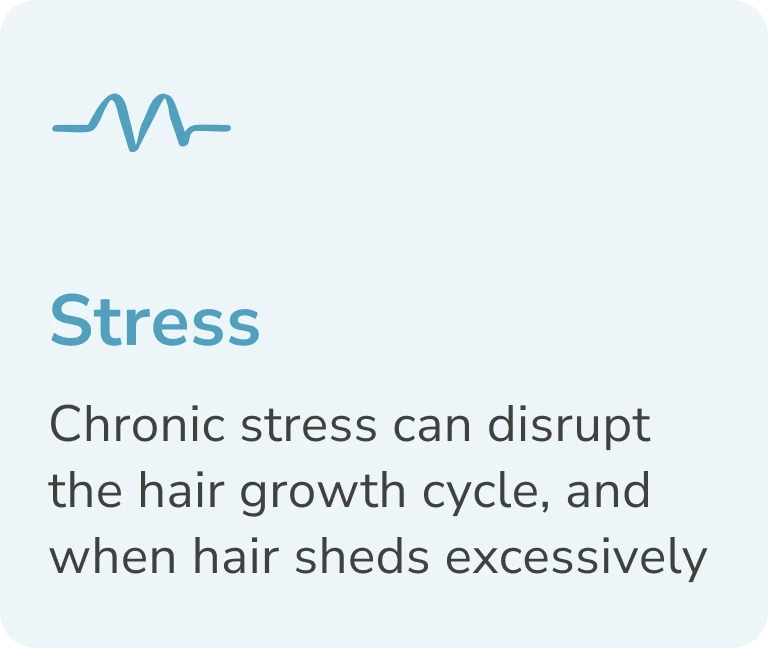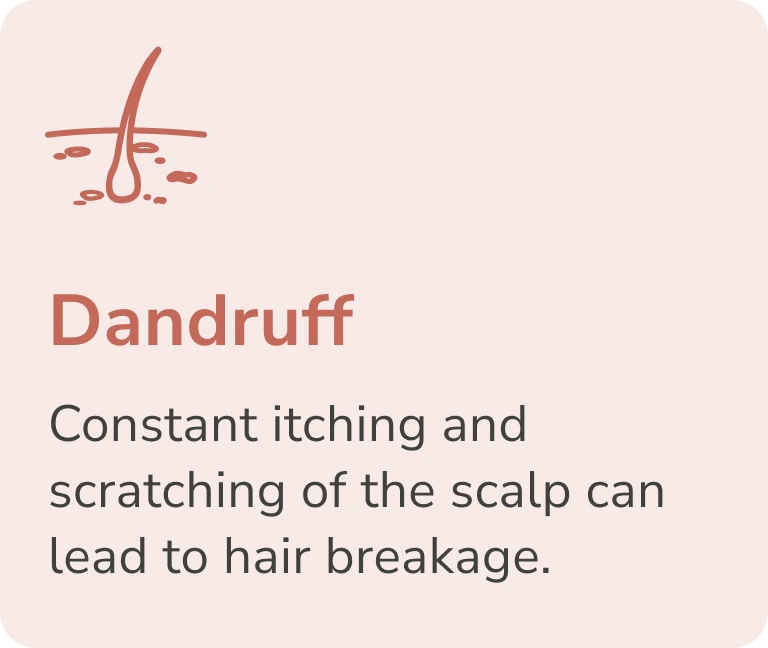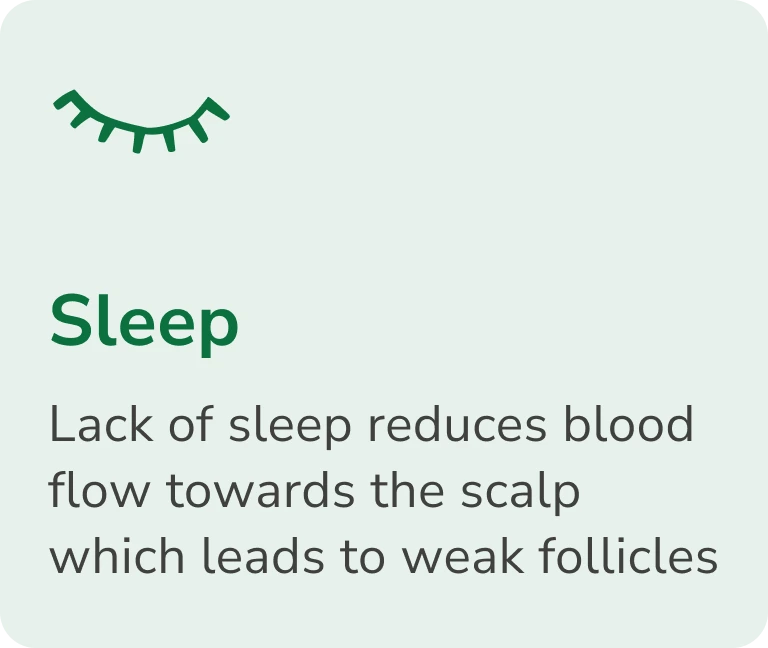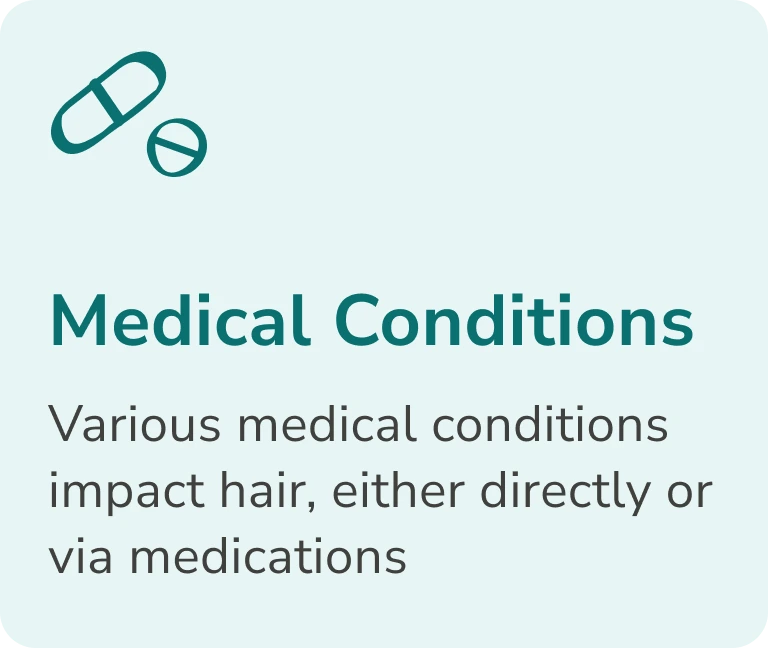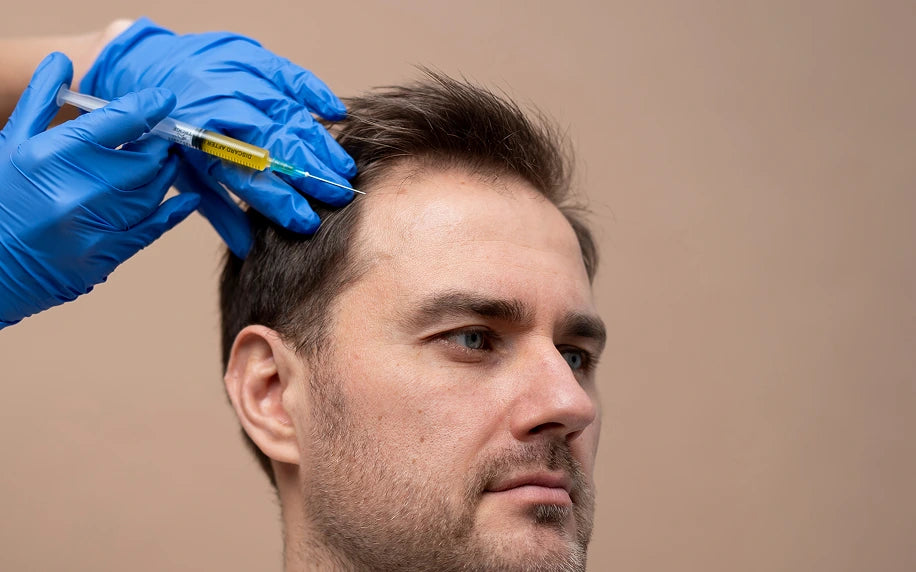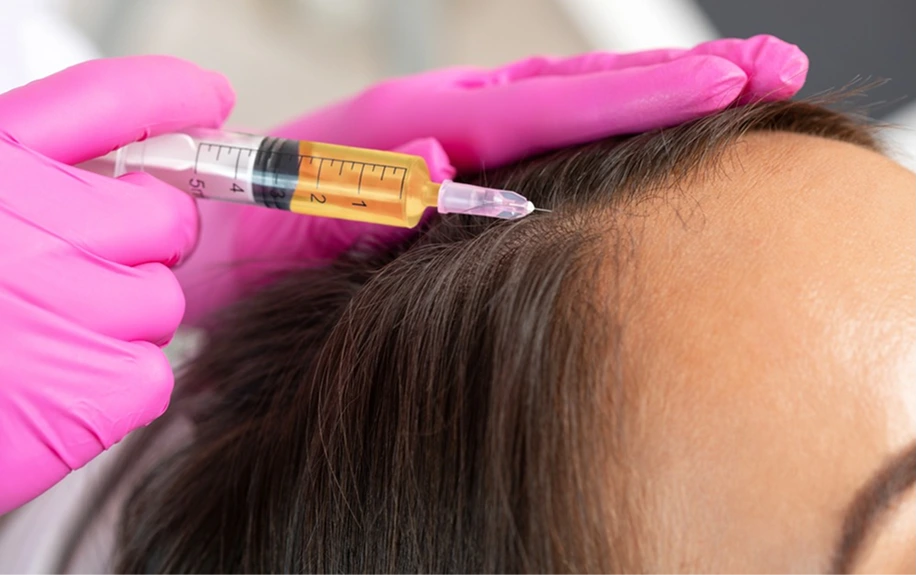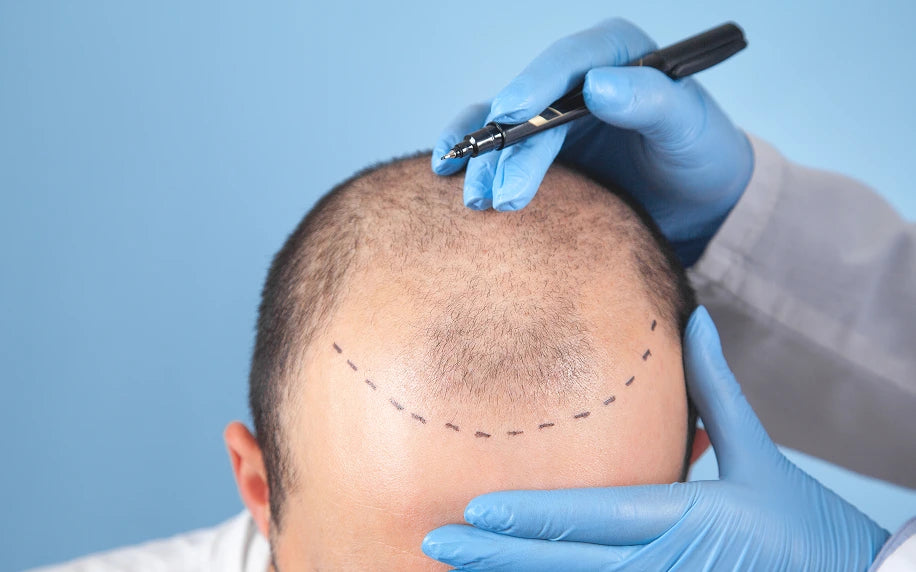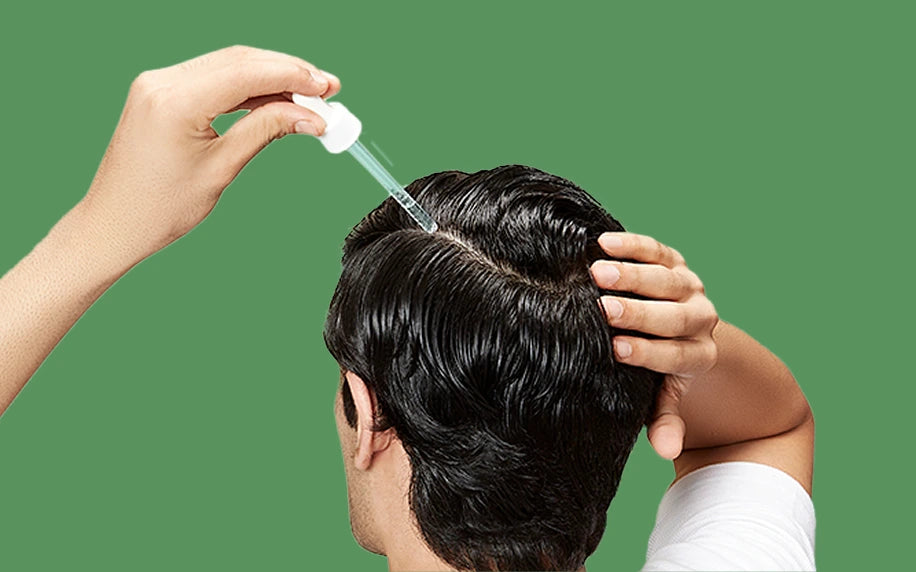One test unlocks hair secrets
Find the personalized regimen for every unique hair concern with expert-recommended test

Dandruff

Dull Hair

Split ends

Hairfall

Frizzy Hair

Tangling
Know your stage to reason to the solution
Male Hair Loss Stages

Stage 1

Stage 2

Stage 3

Stage 4

Coin size patch
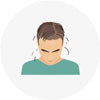
Heavy Hair fall
Female Hair Loss Stages
Texture loss

No Widening
Starting to see widening
Medium widening

Advanced widening
Why Choose Traya?
3x Better
Traya's treatment is clinically proven to be better than just Minoxidil
10 Mn+
Traya has supported over 10 million people in their hair growth journey
50+ Experts
When we say 'personalised' we deliver!
93%
Saw results after consistently using the treatment for 5-months
TRAYA’S HOLISTIC PLAN FOR HAIR FALL
AYURVEDA + DERMATOLOGY + NUTRITION
Our approach combines the goodness of three sciences. With ingredients from the most authentic sources, we personalize your treatment delivering assured results.
TAKE HAIR TEST TMFAQ'S
Q: What is the difference between hair shedding and hair loss?
A: Hair shedding is when old hairs fall out as part of the natural cycle (you normally lose ~50–100 hairs daily). Hair loss or thinning (alopecia) means too much shedding or not enough regrowth, leading to visible thinning or bald spots. Losing more than ~100 hairs per day can indicate excessive shedding or a hair-loss condition. If you notice clumps of hair falling out (e.g. when shampooing) or thinning patches, that suggests more than normal shedding. Persistent thinning or bald patches should be evaluated with a professional hair loss diagnosis.
Q: How much hair loss is normal?
A: It’s normal to lose roughly 50–100 hairs daily as old hairs make way for new growth. That hair often isn’t noticeable until it accumulates on your brush or pillow. If you find large clumps coming out or see a lot more hair than usual on clothing, it is called persistent shedding which has multiple causes. In short, losing a small handful of hairs occasionally is normal. Still, much more than that suggests a hair loss issue (like telogen effluvium or pattern baldness) that may need attention.
Q: What is the best treatment for pattern baldness?
A: The “best” treatment depends on the cause and the individual. For androgenic alopecia, medically proven treatments include minoxidil (a topical solution) and finasteride (an oral medication for men). This slow hair loss can regrow hair in many users. Other options include low-level laser therapy, PRP injections, or hair transplant surgery in advanced cases. However, the most effective approach is often a personalised one. For example, professional hair loss diagnosis by Traya's Free 2-Minute Hair test gives a tailored plan that combines clinically-proven meds with targeted supplements and lifestyle changes. A custom regimen (hair growth treatment plus nutrition) works better than any single “one-size-fits-all” product.
Q: Can female pattern hair loss be treated?
A: Yes, there are treatments for women’s pattern thinning (FPHL). Topical minoxidil is FDA-approved for women and can thicken hair over time. Spironolactone (a hormonal medication) is sometimes used to block androgens. Nutritional support (iron, biotin, vitamin D) is also important. The key is to identify triggers (like anaemia or thyroid issues) and address them. Often, a combination of therapies is used. Many women respond to a comprehensive plan that includes scalp treatments, vitamins, and managing hormone imbalances. Consulting a dermatologist and seeking medical help is always a good step. Traya’s personalised approach also works for many women, matching supplements and topical products to your needs.
Q: What is the best treatment for pattern baldness?
A:The most effective treatment for pattern baldness depends on the individual. Common options include minoxidil (topical), finasteride (oral, for men), and low-level laser therapy. Traya offers a personalized hair treatment plan that combines clinically approved medications, herbal supplements, and nutrition guidance to target the root causes of hair loss.
Q: Can female pattern hair loss be treated?
A:Yes, women can treat pattern hair loss (FPHL) effectively. FDA-approved minoxidil, hormone-balancing medications like spironolactone, and nutritional support (iron, vitamin D, biotin) can help. Identifying the root cause whether hormonal, nutritional, or stress-related is key. A personalized treatment plan ensures the best long-term results.
Q:How long does it take to see results from hair growth treatment?
A:Yes, Traya uses doctor-approved treatments made from clinically tested ingredients. Plans may include minoxidil, biotin, herbal extracts, and prescription medications. All regimens are personalized and reviewed by certified doctors in Dermatology, Ayurveda, and Nutrition. Always follow dosage guidelines and disclose your medical history before starting any treatment.
Q: Are Traya’s treatments and supplements safe?
A:Once you complete Traya’s free hair test, your answers are reviewed by a panel of expert doctors. You’ll receive a personalized hair loss diagnosis explaining your root causes, followed by a custom treatment plan. Ongoing support and progress tracking ensure your hair health improves over time.
Q: What happens after I complete the free Traya hair test?
A:Traya’s online consultation starts with a detailed questionnaire analyzing your lifestyle, health history, digestion, and stress levels. Your data is reviewed by a team of doctors across three fields Dermatology, Ayurveda, and Nutrition. This integrative approach leads to a customized, root-cause-based hair treatment plan tailored to your needs.
Q: How does Traya’s online hair consultation work?
A:Yes, most people experience hair loss due to more than one factor such as hormonal imbalance, poor digestion, nutrient deficiencies, or chronic stress. Traya’s diagnosis is designed to identify all root causes and develop a comprehensive treatment strategy that targets them simultaneously.
Q: Can hair loss have multiple root causes?
Q: Will Traya’s diagnosis improve my overall health too?
Collapsible content
Also Read
How does Traya understand the root cause of your hair fall?
Have you been experiencing hair fall? We here at Traya believe that hair fall is not just a problem but a symptom of something greater. Traya’s Hair Treatment uses a Three-Science approach that considers treating your body as a whole, rather than just your hair. It all starts with a simple online hair diagnosis. This diagnosis includes questions about your scalp condition, lifestyle, stress levels, digestive health, medical history, and family history of hair loss. It evaluates your:
-
Scalp quality
-
Hair quality
-
Lifestyle and stress levels
-
Digestion and gut health
-
Medical history and genetic factors
Your answers are carefully reviewed by a team of expert doctors across three domains. By combining modern medical science with ancient Ayurvedic principles, we can accurately identify whether your hair fall is due to hormonal imbalances, poor gut health, nutritional deficiencies, chronic stress, or a combination of these factors.
This detailed diagnosis helps us create a personalised treatment plan that targets the root causes and sets you on the path to long-term hair regrowth.
Can I have more than one root cause of hair fall?
Yes, and in fact, that is quite common. Hair fall usually does not happen because of just one reason. It is almost always a combination of factors like hormonal imbalance, poor digestion, high stress, nutritional deficiencies, or even scalp issues.
That is why Traya’s diagnosis looks at your entire body, not just your hair. Our expert doctors identify all the underlying causes, allowing your treatment plan to target each one effectively. This way, you get to the root of the problem and see long-lasting results, not just temporary fixes.
How long does it take to see results with Traya?
Month 1: The internal triggers that are increasing your hair loss will improve. Such as constipation, poor digestion, low energy (poor metabolism), and dandruff (including itching and irritation caused by dandruff). If you have started using minoxidil, it will trigger the telogen or shedding phase so that your thin and unhealthy hair starts falling. But don’t worry, that is completely normal and will subside in a few weeks and there will be hair fall control. This is also the month when the hair coaches will try to encourage you to start healthy habits such as a healthier diet, increased hydration and 30 minutes of exercise.
Month 2: We will start you on Traya Ghrit (nasal drops), this is part of the Ayurvedic Nasya therapy that will improve your sleep quality and relieve stress, both of which are major triggers of hair loss. This is the time when hair loss shedding that started after using minoxidil will stop for most of you. If you have been following the dietary restrictions and suggestions you will also start feeling healthier overall.
Month 3: This is the transition month when your hair follicles are getting healthier from the nourishment provided by the herb mixes and the Nasya therapy. So, they have stopped shrinking and are now preparing for the anagen phase of new healthy hair.
Month 4: This is the time your serum is finally starting to show results, so you will start seeing baby hair sprout from areas where you had hair thinning and scalp visibility.
Month 5: Your baby hair will start maturing and your hair shedding will be normal.
Month 6 onwards: You will start seeing a visible difference in your hair volume. Your scalp visibility will have reduced enough for people to notice. This is the time for compliments. Whenever you have reached the end of your hair treatment course the hair coach will guide you about the maintenance plan to ensure you can sustain the long term results.
Do I need to take the treatment forever?
Not at all. Traya’s goal is not to keep you on treatment forever. We wish to help fix whatever is going wrong inside your body so your hair can stay healthy on its own. Once your root causes are addressed and your hair cycle is back on track, you can gradually reduce or discontinue the treatment under the guidance of our medical team. That said, if you have a chronic or genetic condition, you might need some long-term support to maintain results.
Is Traya’s diagnosis backed by doctors?
At Traya, your treatment plan is carefully designed by a team of certified doctors who specialise in Ayurveda, Dermatology, and Nutrition. We believe that hair loss is not just a surface-level issue, it is often a sign of something deeper going on inside your body. That is why our medical team takes an integrative approach.
Your diagnosis is reviewed from three expert lenses:
-
Ayurvedic doctors understand your body’s internal imbalances and doshas.
-
Dermatologists focus on the health of your scalp and hair.
-
Nutritionists ensure your diet and lifestyle are aligned with your recovery.
Together, they develop a treatment plan that not only targets hair loss but also addresses the root causes whether it is poor digestion, stress, or hormonal imbalances. The result? A truly personalised, clinically sound, and natural approach to restoring healthy hair.
What happens after I take the hair diagnosis?
Once you complete the Traya Hair Test, your responses do not just sit in a system, they are carefully reviewed by our team of expert doctors across Ayurveda, Dermatology and Nutrition. We analyse your answers to understand the real reasons behind your hair fall, whether it is hormonal changes, digestion issues, stress, or genetics.
Based on the analysis from all information provided through the Traya hair test, you will receive a detailed diagnosis report that explains what is causing your hair loss in simple terms. Along with this, we will send you a personalized treatment plan that is built just for you.
But your journey does not end there. Once you begin your treatment, our support team stays in touch to guide you at every step. We check in regularly, track your monthly progress, and make adjustments to your plan if needed, so you are never alone on your way to healthy hair.
How does Traya understand the root cause of your hair fall?
Traya follows a unique, science-backed approach that brings together the best of Ayurveda, Dermatology, and Nutrition. When you take the online Traya hair test, we ask you questions about your lifestyle, diet, stress, and medical history, not just your hair. Why? Because hair loss usually starts from within.
Your answers help our team understand the exact internal and external reasons behind your hair fall, whether it is due to hormones, digestion, stress, or something else. Based on this, we create a report and a Traya treatment plan that is fully personalised to your needs.
This way, you are not just treating the symptoms you are addressing the root cause.
Can I have more than one root cause of hair fall?
Yes, absolutely. Hair fall usually does not happen because of just one thing. It is often a mix of many factors. Conditions such as poor gut health, stress, hormonal imbalances, nutritional deficiencies, or even scalp infections can all contribute to hair loss.
That is why at Traya, we do not just look at your hair we look at your whole body. Our diagnosis is holistic, meaning we thoroughly investigate all the reasons behind your hair loss. This helps us create a Traya treatment plan that tackles every root cause, so you get long-lasting results. And the first step to create a special Traya Treatment plan is to take the Traya hair test.
How will Traya help treat my root cause?
Once we find out what is actually causing your hair fall, you will get a personalised treatment plan made just for you. This includes Ayurvedic herbs, doctor-prescribed medicines, diet tips and simple lifestyle changes which are all designed to target your specific root causes.
Whether your issue is hormonal imbalance, poor digestion, stress, or scalp health, we make sure every part of your plan is focused on fixing it. And you are not left on your own. Our doctors track your progress regularly and make changes if needed to keep you on the right path.
It is not just about hair, it is about getting your whole system back in balance.
Will Traya make me healthy overall?
Yes! At Traya, we do not just treat the symptoms we focus on your overall health. Since your treatment includes support for nutrition, gut health, stress, and hormones, many users also notice other positive changes.
Things like better sleep, improved digestion, increased energy, and overall feeling healthier often occur along the way. That is because we believe healthy hair can only grow from a healthy body, and we help you work on both.



